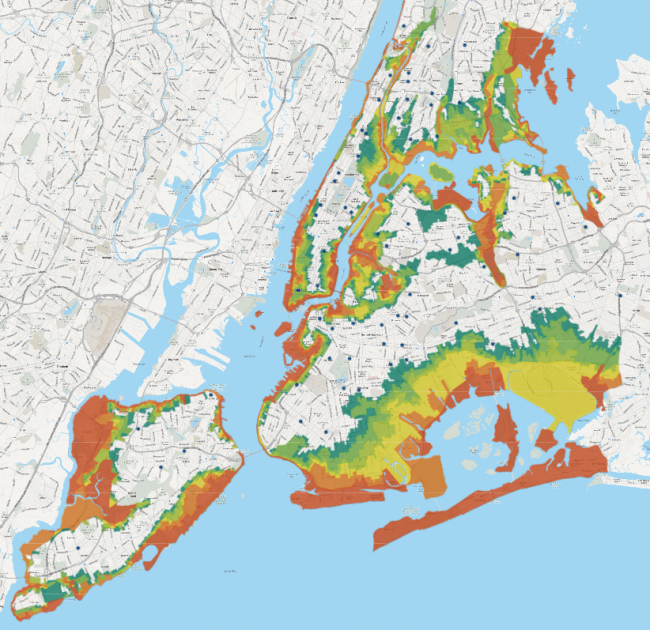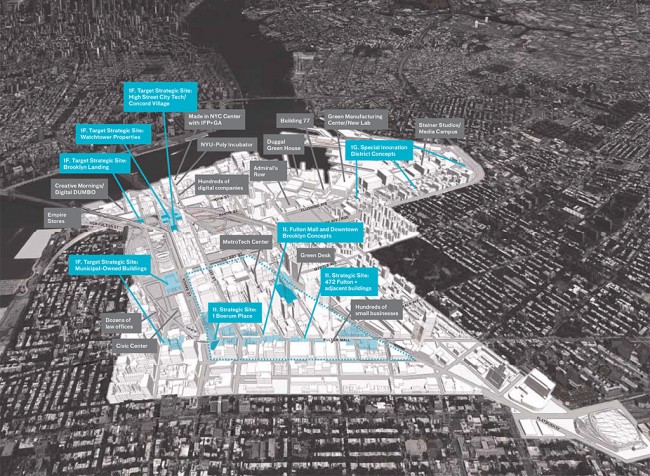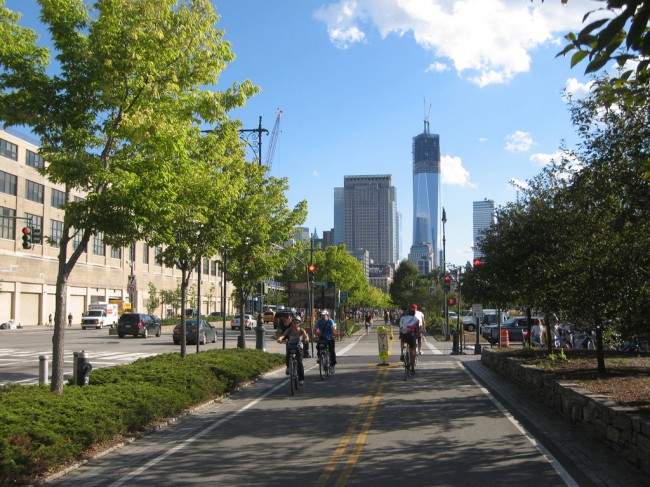
We are celebrating 15 years — and counting — of stories that are deeply researched and deeply felt, that build a historical record of what the city has been.
We are celebrating 15 years — and counting — of stories that are deeply researched and deeply felt, that build a historical record of what the city has been.

Updated NYC Storm Evacuation Map | Courtesy of the NYC Office of Emergency Management
STORM EVACUATION ZONES AND REBUILDING BY DESIGN
Last week, Mayor Bloomberg unveiled a $20 billion storm protection plan and proposed several building code changes based on the work of his Building Resiliency Task Force. Following on the tail of these announcements, the Bloomberg administration released a new map with updated storm evacuation zones on Tuesday. Instead of the previous three zones labeled A–C, there are now six zones numbered 1-6, with Zone 1 being the most vulnerable area. The result: 600,000 more residents (totaling almost 3 million New Yorkers) now live in areas officially recognized as being at risk of flooding.
On Thursday, the U.S Department of Housing and Urban Development (HUD) announced the launch of REBUILD BY DESIGN, a multi-stage design competition looking to bring together experts in design, engineering, planning, communications, and other fields to tackle resiliency issues at every scale, “from large-scale green infrastructure to small-scale residential resiliency retrofits,” with the intention of promoting innovation. Hoping to foster coordination across borders and regions, the competition is a partnership with the National Endowment for the Arts and the Rockefeller Foundations, and is looking to start construction on the selected projects by March 2014.
CHARGE IN THE PARK
Soon you’ll be able to recharge a low cell phone battery with a trip to the park. Last year, design firm Pensa brought their prototype solar charging station to a park in Brooklyn, and now they’ve teamed up with Goal Zero and AT&T to expand the project. Charging stations will be installed in nine different parks throughout the summer, the first of which went up in Fort Greene Park on Tuesday. Coney Island, Governors Island, and Union Square are among the sites next in line.
COMPOSTING FOR ALL
Contradicting the arguments that New York City is too dense and vertically structured to implement municipal composting successfully, pilot programs have seen unexpected success. As a result, the City is planning to roll out a longterm, city-wide composting program in the next few years, calling food waste “New York City’s final recycling frontier.”

The Brooklyn Tech Triangle | Image via The Brooklyn Tech Triangle Initiative
BROOKLYN BOOMING
New York City officials’ dream of overtaking Silicon Valley as the largest tech hub in the nation is getting another push. The Brooklyn Tech Triangle Coalition released a detailed, and lengthy, plan (summarized by The Architect’s Newspaper and Gothamist) to make the Brooklyn Tech Triangle — the space between Downtown Brooklyn, DUMBO, and the Brooklyn Navy Yard — an attractive location for tech startups and an economic engine for the city. In addition, the development of BAM South will finally move forward. Currently a parking lot, the new development will include a 20,000 square foot public plaza, 300 apartments, and a 50,000 square foot community and cultural facility.
STATE OF THE CITY’S PARKS
Although the past decade has seen a boom in new park development across the city, the quality of parks across the five boroughs is far from equal. The New York Times examines the underlying reason for the disparities (and a key flaw in the city’s parks system): funding for smaller park projects is often dependent on city councilmembers and borough presidents, rather than the Parks department, who may direct their district’s funding at their own discretion.
THE CENTER OF THE MELTING POT
The diversity of Queens gets confirmed and analyzed by the Times Ledger, which drew upon census data to pick apart the bustling borough’s demographic composition.
LANDSCAPE URBANISM: RETHINKING INFRASTRUCTURE
The journal Landscape Urbanism released its latest issue, “Scenario 4: Rethinking Infrastructure,” exploring the potential for infrastructure projects to address the needs of the next century, a favorite UO topic. Frequent Omnibus readers might recognize some past contributors and projects, including Margie Ruddick on her continuing work (she discussed with us in 2009) at Long Island City’s Queens Plaza, and dredging and natural sediment systems (which we discussed with Dredge Research Collaborative founder Tim Maly).
Elsewhere in the Journal, Laura Tepper takes a look at the third section of the High Line and future plans for its opening to the public. Currently featuring Carol Bove’s Caterpillar sculptures, the final section gives a feel for the state of the entire elevated track before being transformed into one of the city’s most popular public spaces. Friends of the High Line is currently offering tours of the space; check it out before construction starts later this year.

Manhattan’s West Side Bike Path | Image courtesy of John O’Connell
ECONOMIC SNAPSHOT: WALKING AND BIKING
The NYCEDC took on the difficult task of quantifying the economic effects of running and biking in its monthly economic snapshot, providing new ammunition for public space and health advocates.
EVENTS and STUFF TO DO
THE OLYMPIC CITY
Tonight, stop by the opening reception of Jon Pack and Gary Hustwit’s photography project, The Olympic City, which documents the built legacy of the Olympic Games in former host cities around the world. The duo use the international event as a lens to explore the role of architecture and urban space in our cultural identity, a theme Hustwit spoke with Urban Omnibus about in 2011, after the release of his film, Urbanized. The exhibit is up until July 10th at the Powerhouse Arena in DUMBO.
ROOFTOP CAMPING
Dreaming of the outdoors but can’t / don’t want to get out of the city? For his project Bivouac NYC, Artist Thomas Stevenson has temporarily turned a secret rooftop in Brooklyn into a campsite. Sign up for one of the July dates before the camp is all booked up.
MACKTEZ SUMMER STIPEND
Applications for the Macktez Summer Stipend will be accepted starting on June 21st. The tech consultancy offers a development grant to give creative people from all disciplines a chance to pursue and prioritize their personal summer projects. The proposals are judged on three criteria: originality, relevance, and conviction.
The Roundup keeps you up to date with topics we’ve featured and other things we think are worth knowing about.
The views expressed here are those of the authors only and do not reflect the position of The Architectural League of New York.